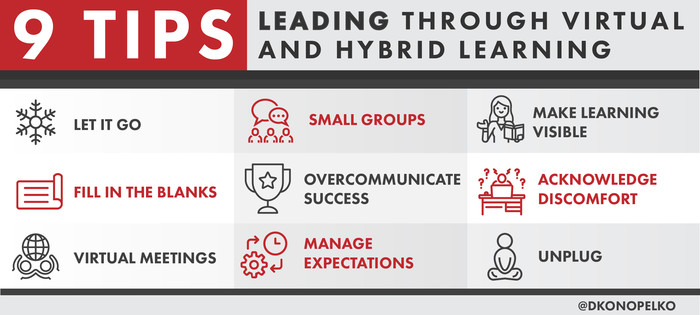4. Embrace small-group and one-on-one meetings: Large meetings held virtually are often ineffective unless accompanied by small-group breakout sessions. Platforms such as Zoom, Google Meet and Microsoft Teams allow for dynamic breakouts and provide an interactive experience for staff. These platforms also come with tools to boost engagement, such as screen-sharing, digital whiteboards and polls. Lee recommends breaking out participants into groups of four or five. This allows new people to shine as leaders while enabling maximum interaction in their groups, she explains. Also, to promote further productivity, “ensure that breakout sessions have a clear focus, a clearly communicated work time and a deliverable,” she says.
READ MORE: Find out how to best use Google Meet and Microsoft Teams for remote learning.
5. Make learning visible: School leaders and other educators should share what they’ve learned with each other. April Mayo, director of instructional technology for CCPS, encourages staff to share relevant tips and tricks on a collaboration platform. There are also ample opportunities to attend online lectures, training webinars and panel discussions.
6. Overcommunicate success: It’s also important to share successes with staff, students and parents, whether through phone calls, social media, email, or the district or school website. At CCPS, Superintendent Dr. Morcease Beasley even started his own podcast, “Be Inspired with Beasley,” to spread the news about the good work his district is doing to the rest of the community. Beasley points out that “a story will be told about how well your district or school operated during this time; be sure you are the one writing the narrative.”
DISCOVER: Read how the remote learning pivot sparked innovation in education.
7. Manage expectations: Learning remotely is a big shift. Teaching remotely is a big shift. Leading remotely is a big shift. Facilitating and implementing all of these simultaneously during uncertain times is a monumental shift. That said, expectations are not the same as when everyone was on campus. Therefore, school leaders need to be deliberate about communicating changes in expectations with students, educators and other school employees. They should not make assumptions that any changes are automatically understood.
8. Stay connected, but don’t forget to unplug: Working remotely can be very lonely, so school leaders are encouraged to support the well-being of their colleagues. Encourage them to interact online, whether through quick video call check-ins or virtual happy hours after school. It’s also important to remember that achieving work-life balance may be more difficult for some when they’re working from home. “Remember, it is important to unplug from digital tools because it is incredibly easy during this time to be accessible beyond the workday,” Beasley says. Sharing mental health and wellness resources is also key and can help educators avoid burnout.
9. Acknowledge discomfort: These transitions are tough, and they can’t happen overnight. School leaders should not pretend that everything is normal and ignore the challenges their staff members are experiencing. Asking how they are coping with those challenges and offering to help makes a world of difference. “Don’t forget to reach out to the appropriate support, digital learning specialists and technology liaisons for help when needed,” Mayo adds. “Ensure staff know who their support is, and that they take advantage of their support.”












